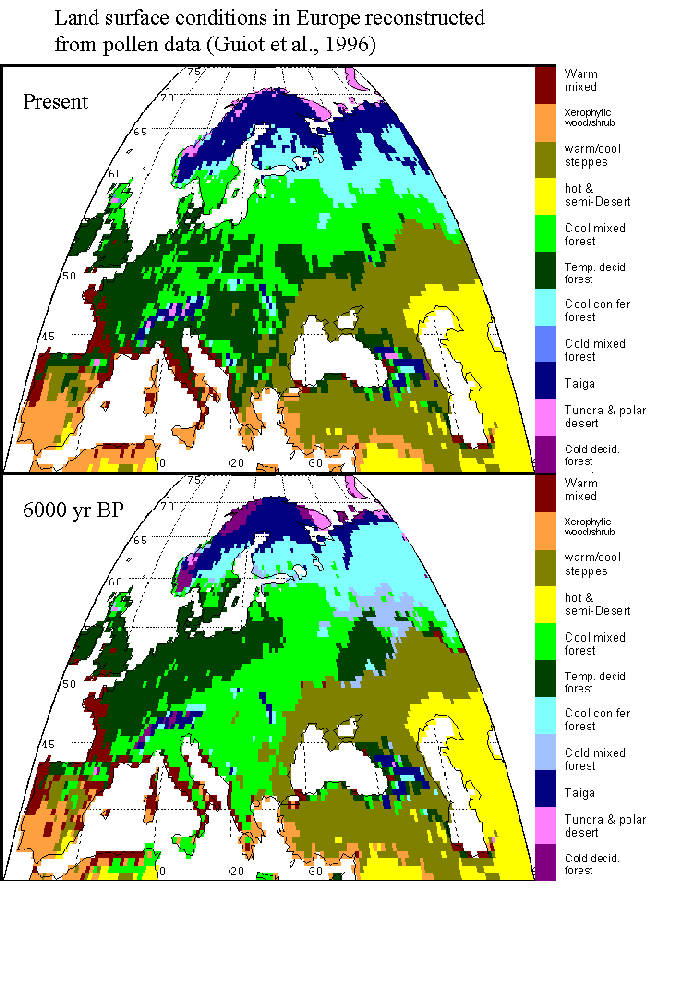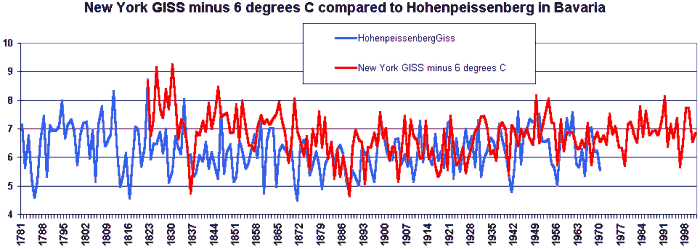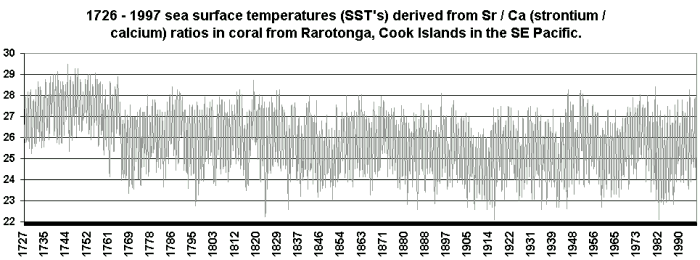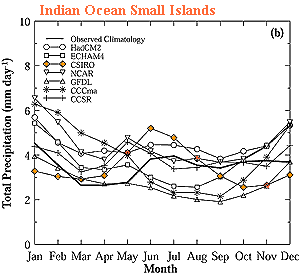
References:
Guiot J, Harrison SP, Prentice IC (1993) Reconstruction of Holocene
precipitation patterns in Europe using pollen and lake-level data.
Quaternary Research 40: 139-149.
| Greenhouse, global warming, climate
change, IPCC events, news, articles, mostly from the Internet
& email groups, much of which will never find its way to mainstream media.
The idea is to post new material as soon as it comes to hand and maybe close
off issues each month. Feedback and articles
to climate@webace.com.au please. I trust all the original authors are acknowledged, I have tried to include url's to their sites where available. |
Contents in order: NASA finds land use changes as important as greenhouse gases; Reply from IPCC to Ian Castles; New York cools more than Central Europe; Northern Europe warmer in Bronze Age. SE Pacific no warmer than earlier periods, corals say. Early snow hits SW Scandinavia Bob Foster and others on CSIRO model projections |
NASA Top Story October 1, 2002
LANDCOVER CHANGES MAY RIVAL GREENHOUSE GASES AS CAUSE OF CLIMATE CHANGE
"Our work suggests that the impacts of human-caused landcover changes on
climate are at least as important, and quite possibly more important than
those of carbon dioxide," said Roger Pielke, Sr., an atmospheric scientist
at Colorado State University, Fort Collins, Colo., and lead author of the
study. "Through landcover changes over the last 300 years, we may have already
altered the climate more than would occur associated with the radiative effect
of a doubling of carbon dioxide."
Dear Dr. Pachauri,
Thank you for your message of 30 September, advising me of the serious consideration
that is being given within the IPCC community to the matters raised in my
email to you of 29 August and the article enclosed therewith.
I am grateful to you for bringing my views to the attention of the entire IPCC Bureau, and of course I agree that you need to carry out a full consultation with the Bureau before responding to me in detail.
I look forward to receiving your substantive response after the next Bureau meeting in December.
With warm best wishes,
Ian Castles
Ian Castles
Visiting Fellow
National Centre for Development Studies
Australian National University
Ph: 61 2 6295-7814
----------
>From: "Chairman IPCC" <chairipcc@teri.res.in>
>To: <ian.castles@anu.edu.au>
>Subject: Re: Emissions Projections
>Date: Mon, 30 Sep 2002 9:21 PM
> Dear Dr Castles,
>
> I am most grateful to you for your email of August 29, 2002. I
am sorry
> that it has taken me a month to acknowledge your communication, but there
> are two reasons for my apparent tardiness. Firstly, I have been
heavily
> preoccupied with the WSSD at Johannesburg and subsequently some aspects
of
> preparations for CoP-8. Secondly, I did want to get the opinions
and
views
> of several members of the IPCC community, who have been pursuing an
> electronic discussion of your article and the views contained in it.
>
> I have now brought this to the attention of the entire IPCC Bureau, and
we
> would take very serious interest in what you have written, and discuss
it
> in the next Bureau meeting in December. I shall then be able to
get back
> to you in some detail. Meanwhile, I would be grateful if you could
bear
> with me and appreciate the fact that as a procedure I need to carry out
a
> full consultation with the Bureau to do justice to what you have written
> and to ensure that the IPCC can act on it appropriately.
>
> With kind regards,
> Yours sincerely,
> R K Pachauri
> R K Pachauri, Ph.D
> Chairman
> IPCC (Intergovernmental Panel on Climate Change)
> C/o TERI
> Habitat Place, Lodhi Road
> New Delhi 110 003 India
> Tel: +91-11-4682121/2122
> Fax: +91-11-4682144/2145
> Website: www.ipcc.ch
>
>>>> "Ian Castles" <ian.castles@anu.edu.au> 08/29/02 06:34AM
>>>
> Dr. Rajendra Pachauri,
> Chairman,
> Intergovernmental Panel on Climate Change
At Coolwire we are not holding our breath
in anticipation that the IPCC will seriously address the damning issues raised
by Dr Castles. It will still be interesting to see how they wriggle out of
the grip of his arguments.

The following maps show vegetation zones derived from fossil pollen studies
in Europe, references below. Clearly past climate changes can be greater
than those attributed by the "greenhouse industry" to recently inceasing
levels of atmospheric carbon dioxide.

References:
Guiot J, Harrison SP, Prentice IC (1993) Reconstruction of Holocene
precipitation patterns in Europe using pollen and lake-level data.
Quaternary Research 40: 139-149.
Cheddadi, R. Yu, G. Guiot, J., Harrison, S.P. and Prentice, I.C. (1997):
The climate of Europe 6000 years ago. Climate Dynamics, 13: 1-9.

ABSTRACT: A 271 year record of Sr/Ca variability in a coral from
Rarotonga in the South Pacific gyre. Calibration with monthly sea surface
temperature (SST) from satellite and ship measurements made in grid
measuring 1° by 1° over the period from 1981 to 1997 indicates that
this Sr/Ca record is an excellent proxy for SST. Comparison with SST
from ship measurements made since 1950 in a grid measuring 5° by 5°
also shows that the Sr/Ca data accurately record decadal changes in
SST. The entire Sr/Ca record back to 1726 shows a distinct pattern
of decadal variability with repeated decadal and interdecadal SST regime
shifts greater than 0.75°C. Comparison with decadal climate variability
in the North Pacific as represented by the Pacific Decadal Oscillation
index (1900-1997) indicates that several of the largest decadal-scale
SST variations at Rarotonga are coherent with SST regime shifts in the North
Pacific. This hemispheric symmetry suggests that tropical forcing may
be an important factor in at least some of the decadal variability
observed in the Pacific Ocean.
Onar Åm Reports too:
It snowed in Stavanger today, too. Snow in October is rare in the southern
parts of Norway, especially at the west coast, like Stavanger.
Dear Onar,
What we are experiencing is the first Mobile Polar High this winter season
moving southward quite quickly along the western border of Scandinavia.
There will always develope a low pressure zone on the east side of these MPHs.
That´s why the western parts of south Sweden got hit without anything
happening in the Stockholm area. Just some minutes ago it was reported
in the weather news that some part along the west coast got up to 500 mm
snow. 20000 people are out of electricity just now. Tomorrow
when more cold air has been pump southward the temperature is expected to
get down to -15°C in the southwestern parts of Sweden according to TV
weather news. This is an example of what a MPH can and will do, a physical
prosess which is not taken into account in GCMs.
All the best
Hans Jelbring
On the subject of GCM's (General Climate Models) and after some time spent with Australia's climate modelers: Prof. Craig Bohren of The Pennsylvania State University wrote;
"...the words used by modellers indicate to me that they have crossed the line between reality and fantasy. To them, their computer simulations really are experiments on the same footing as the kind in which experimenters get their hands dirty. Modellers discuss the results of their (numerical) experiments in the same way that laboratory scientists discuss theirs. Yet a simulated "experiment' according to Robert Romer (American Journal of Physics, Vol. 61, 1993, p. 128) is "the creation of the devil, and the temptation to use one must be stoutly resisted." I also am sceptical of climate modellers because of their habit of dismissing as inconsequential everything their models cannot treat. Not long ago, clouds were considered to be minor players in the global warming drama. Why? Because modellers couldn't adequately include clouds in their models. Or because modellers are heavily steeped in dynamics, and clouds occupy a low status in the various kingdoms and duchies into which the atmosphere has been artificially divided. My scepticism about climate models is fuelled by their inability to postdict the climate.
To my knowledge, no model run backward in time from the present has predicted the observed temperature decrease that not so long ago was generating alarms about global cooling. It has long been accepted that to acquire validity, a theory must have predictive capabilities. What are we to make of a theory that doesn't even have postdictive capabilities? True, rather than simulated, experiments will provide the evidence for or against global warming just as true, as opposed to simulated, sex is what makes babies."
Reliability of CSIRO climate models re regional projections
Now a comment by Dr James R Mahoney, Assistant Secretary of Commerce,
for Oceans and Atmosphere before the Committee on Science, US House of Representatives,
July 10, 2002.
Dr. Mahoney presents a review of research by the giant US climate group NOAA
(National Oceanic and Atmospheric Administration). Downloadable pdf
file available if you email me.
At the bottom of page 4 under a section headed Continued Scientific Enquiry
he lists 6 bullet points “…illustrative of the need for improved scientific
understanding.”
Point six says “The poor regional performance of general circulation models…”
My bold added.
There it is, Dr. Mahoney is saying that climate models such as the CSIRO
has used to generate future climate scenarios for Australia have a “…poor
regional performance..”.
Finally, a Figure from an IPCC web page crowing about
how well 7 GCM's can replicate seasonal rainfall changes on Indian Ocean small
islands. I have coloured the CSIRO effort.

We see the heavier plain line representing monthly mean observed rainfall
and we see that the CSIRO results fail to capture the major fact of high January
rainfall, getting the lowest of all model results in this regard. Then
the CSIRO get the most exaggerated result of all the models for the
vital months ( for SW WA) of June July. Finally they utterly fail to capture
the salient fact that observed rain is pretty constant through June to December.
Finding instead a huge oscillation in winter / spring rainfall. Altogether
not a performance that would promote CSIRO expertise in predicting
say future regional Australian rainfall.
You read it first here.
Return to Coolwire index
Return to front page